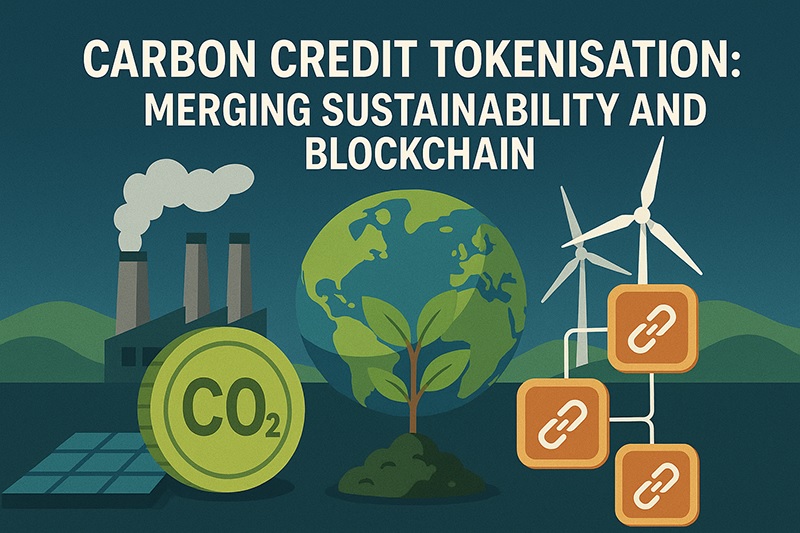Carbon Credit Tokenisation: Merging Sustainability And Blockchain
In today’s scenario of capitalisation, tokenisation of assets is changing the world economy dynamically. It is estimated that the global market for tokenised assets will reach $16 trillion by 2030. This also indicates a dynamic transformation in how real-world assets are owned, traded, and managed. The trend of tokenising assets is ready to bring revolutionary changes in the working of all industries, from securities and real estate to art and carbon credits.
It can be said that among a wide range of innovations initiated to achieve sustainability, carbon credit tokenisation emerges as a promising development combining the powers of blockchain technology with environmental sustainability.
This blog focuses on carbon credit tokenisation, how it works, and how it can contribute to a greener and more transparent global economy.
What Are Carbon Credits?Carbon credits are tradable certificates authorising owners to emit a specific amount of carbon dioxide (CO₂) or its equivalent in other greenhouse gases. The main objective of issuing these certificates is to reduce global emissions by assigning financial value to carbon reduction efforts.
Each carbon credit is equivalent to one metric ton of CO₂, and entities like governments, corporations, or organisations can earn these credits by investing in projects that reduce emissions — such as renewable energy, reforestation, or energy efficiency programs.
How Carbon Credits Work?The carbon credit market works on a cap-and-trade pattern. Governments determine an overall emissions cap and distribute carbon credits accordingly. Companies which cannot reduce the emission levels determined in their certificate can sell their excess credits to those exceeding theirs.
What Is Carbon Credit Tokenisation?Carbon credit tokenisation is the process of converting traditional carbon credits into digital tokens stored and managed on a blockchain. Each token represents a verified carbon unit, which can be easily bought and sold in a decentralised marketplace.
This makes the whole trading process simple, transparent, and minimises the inefficiencies found in traditional carbon markets.
How Carbon Credit Tokenisation Works- Issue of Carbon Credits:
Projects expected to reduce the emission levels, approved by standards like the Verified Carbon Standard (VCS) or the Gold Standard, generate carbon credits. These credits confirm measurable and permanent emission reductions.
- Tokenisation Process:
Each verified credit is digitised into a token backend by blockchain, containing metadata such as project details, emission data, and verification history.
- Blockchain Trading:
Tokenised credits are sold and purchased on decentralised platforms. This allows for secure, immutable, and transparent transactions, eliminating the chances of fraud and double-counting.
- Retirement of Tokens:
Once a credit is used in a project aimed to reduce emissions, its corresponding token is “retired” on the blockchain, which means that particular credit cannot be used further in some other project.
- Transparency:
As a decentralised platform, every transaction recorded on the Blockchain is secured and cannot be altered by anyone. It is easier for everyone in the network to trace its full history from the date when the credit was issued to its retirement. This reduces the chances of fraud and enhances trust among participants.
- Accessibility:
Traditional carbon markets are complex and limited to large players. Tokenisation democratises their reach and allows individuals, startups, and small businesses to participate in carbon trading and initiatives focusing on sustainability.
- Efficiency:
From verification to operating the business, smart contracts automate all tasks and help in controlling administrative tasks and transaction time. This makes the carbon market more agile and cost-effective.
- Smart Contracts:
Through automated and self-executing agreements, smart contracts enable direct transactions and eliminate the need for a middleman. Thus, ensure fair and transparent trading conditions.
- Global Reach:
Tokenisation facilitates cross-border trading, helping unify global carbon reduction efforts. This global accessibility can attract more investments in climate-positive projects worldwide.
The Future of Carbon Credit Tokenisation
- Decentralised Finance (DeFi):
Integration with DeFi can result in the development of new products like carbon credits.
- Internet of Things (IoT):
IoT devices can deliver real-time emissions data, ensuring accurate carbon measurement and enhancing the reliability of tokenised credits.
- Cross-Sector Collaboration:
Partnerships among regulators, technology firms, and environmental agencies will be key to developing global standards and building trust in tokenised systems.
As businesses and governments focus on a greener environment and sustainability, the future of carbon credit tokenisation appears promising. Emerging technologies are expected to strengthen the environment and make it more inclusive.
Upcoming Innovations to WatchCarbon credit tokenisation represents a groundbreaking step toward a sustainable, transparent, and efficient global carbon market. By merging blockchain technology with the protection of the environment, it creates an ecosystem where every participant, from major corporations to individual investors, can actively contribute to the fight against climate change.



